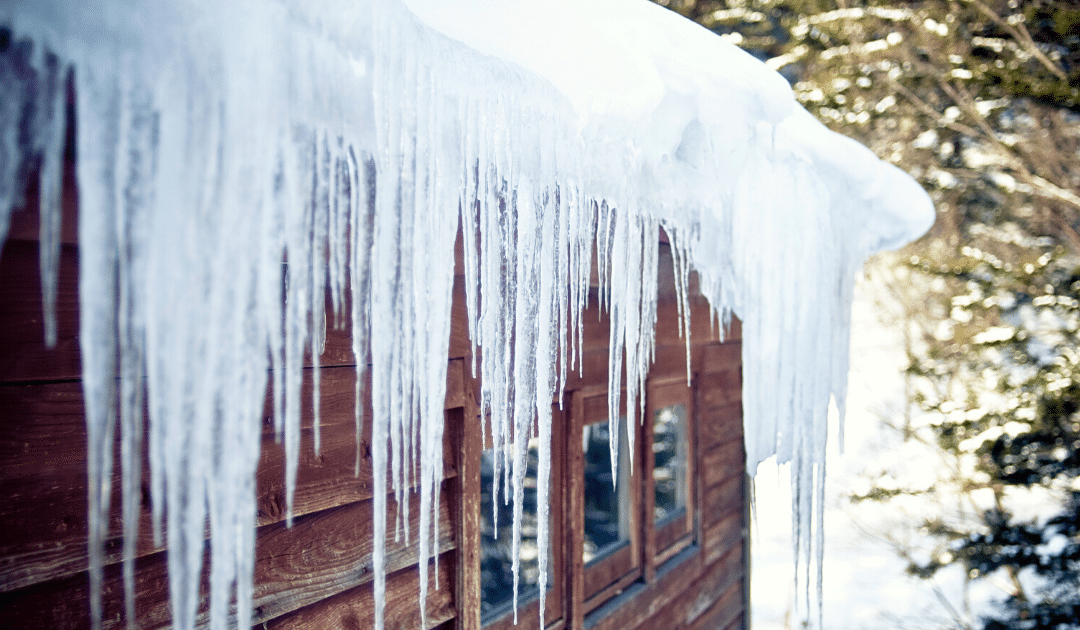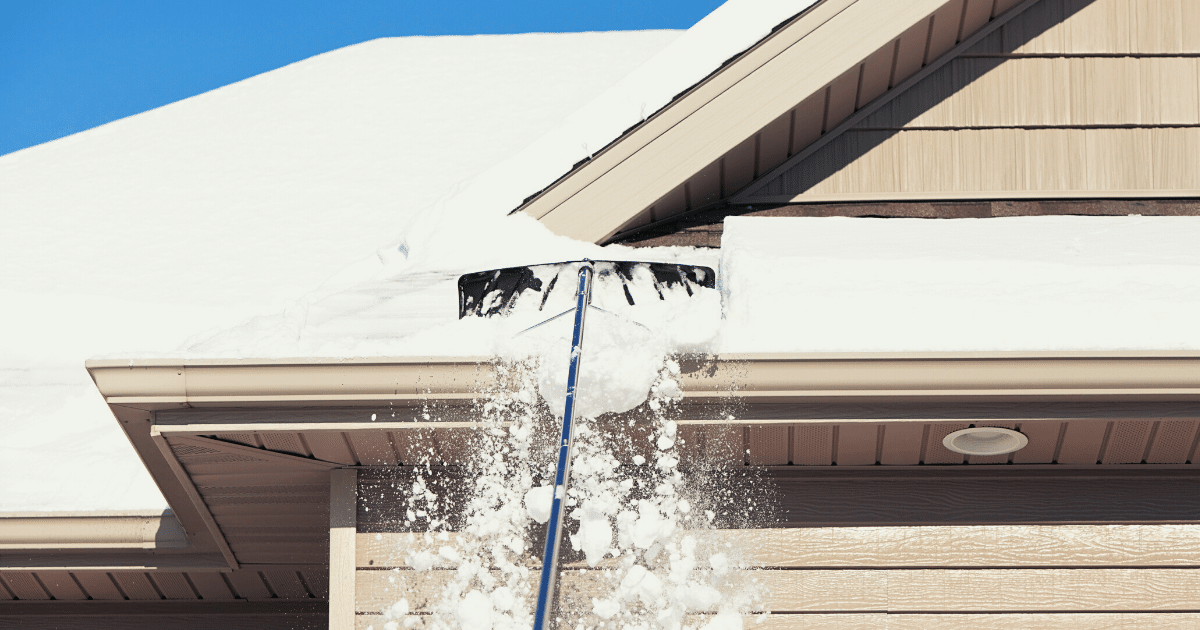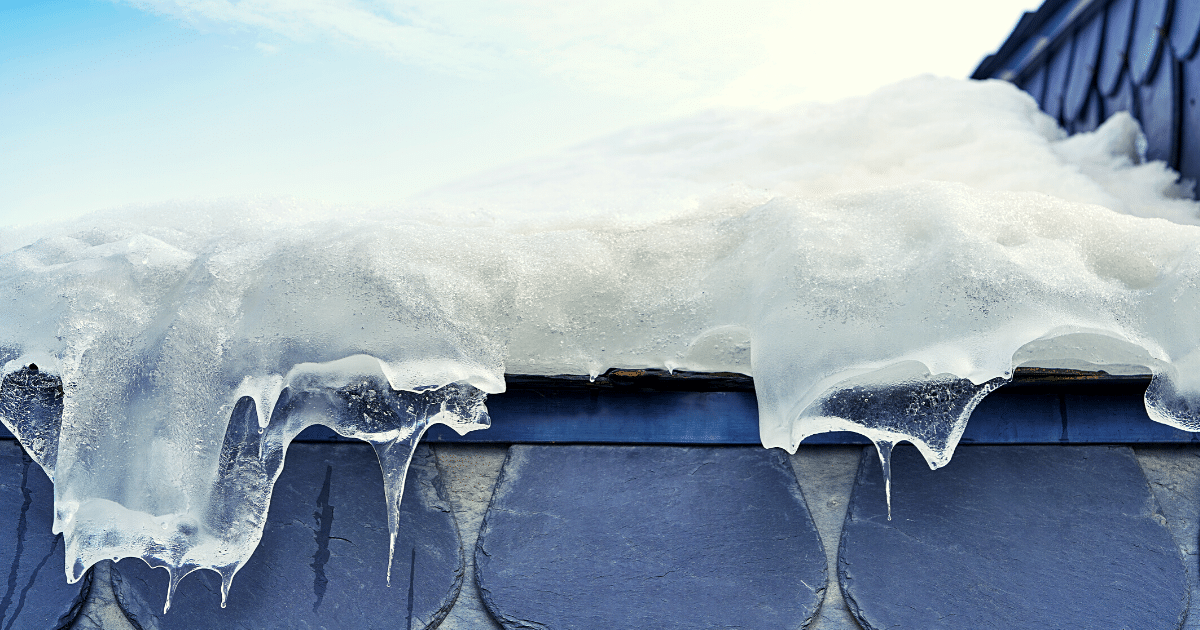Snow build-up packs a double-punch threat to your roof – and home. As snow piles up on your roof, it creates two threats over time. One is a heavy snow weight which, if left unchecked, can pose a risk of roof collapse. The other is the formation and persistence of ice dams.
Ice dams form when warm air rises inside your house and warms the roof, melting water that then runs down the eaves. Since eaves are colder, it refreezes there and creates a solid ice block, which then backs up future run-off water behind it. The more snow you have, the more run-off will accumulate. Also, the greater the temperature difference along your roof and the more time the ice deposits have to grow, the bigger your ice dam problems will be.
Keeping both these threats at bay requires a steady habit of keeping that snow in check.
Rooftop Snow Removal
Rooftop snow is typically removed either by raking or shoveling. Your best bet as a DIYer is raking. If you live in a one-story house, you can probably do this yourself. If you live in a two-story or taller home, or you have an abundance of snow to remove, consider hiring a professional (who will most likely shovel, rather than rake). Here are some top tips for safe snow raking.
-
- Get the right rake – Look for a rake that has these important features. First: small bumpers, wheels, or rollers near the blade. These keep the blade off the roof surface, protecting it from damage. Second, the handle should have a slight bend to it. This makes it more versatile and easier to use than a straight-handled rake. Third, consider plastic over metal because it’s lighter. Finally, a telescoping feature will allow you to reach more snow.
- Buy an extension or two – If your rake doesn’t have a telescoping feature, it’s a good idea to buy extra extension poles so that you can rake as high as possible on the roof. And having an extra pole or two tucked away will be good if your main one gets bent or damaged.
- Rake regularly – Making this an ongoing task throughout the winter will help prevent build-up.
- Have a plan – It’s important to rake in a particular sequence. First, knock down any hanging icicles. Then, with a rake in hand and firm footing on the ground, work your way around the house, starting with the overhangs (which are most prone to ice dams).
- When raking, start low – Start at the bottom of the roof and work your way to the top, pulling off a foot or so of snow at a time. Be warned that starting high or pulling down too much snow could bring it tumbling down on you.
- Stand back – Give yourself some room away from the roof’s edge so that if snow dislodges, it won’t fall on you.
- Watch out for power lines – Be extremely careful not to hit any overhead lines. In fact, take an inspection walk around your house before starting to rake. Overhead lines are common in older homes.
- Think twice before salting – Salting the roof can lead to discolored shingles and dead plants or grass.
Preventing Ice Dams
Ice dams can lead to roof leaks, causing structural damage inside your home, as well as water stains, bubbling paint and wallpaper, and mold/mildew formation. Besides keeping up with snow removal (the best strategy for ice dam prevention), here are some others:
-
- Insulate your attic – This will minimize heat loss, keeping your roof cooler and melting less snow. It will also save on energy costs.
- Eliminate air leaks – Seal leaks in the attic, around the chimney, and at entry points for vents and pipes.
- Vent out the hot air – Proper ventilation will help keep heat from getting trapped and warming concentrated spots on your roof. Consider installing two motor-driven fan vents – one that draws in cold air and one that exhausts hot air.
- Turn down the heat – Dialing down your home temperature will not only help prevent snowmelt and ice dams, but also save on your heating bill. Check out our easy tips here.
- If you already have ice dams – Ice dams can do serious and expensive damage to your home – so if you have them, get them removed by a professional asap.
Preventing wintertime damage to your home saves money and headaches over time. In the case of your roof, keeping it maintained and damage-free will extend its life and protect your home’s value. Follow the strategies above and also remember – if the snow is wet, heavy, voluminous, or hardened you should hire a professional snow shoveling service. Finally, getting a pre-winter roof inspection is always a good idea, as it will surface any structural vulnerabilities or problems with your roof.
For more winter home maintenance tips, click here.
This article is furnished by California Casualty, providing auto and home insurance to educators, law enforcement officers, firefighters, and nurses. Get a quote at 1.866.704.8614 or www.calcas.com.
- Graduation – When to Remove Your Child from Your Auto Policy - May 18, 2023
- How to Prevent Catalytic Converter Theft - May 17, 2023
- How Much Does Home Insurance Cost? - May 17, 2023



